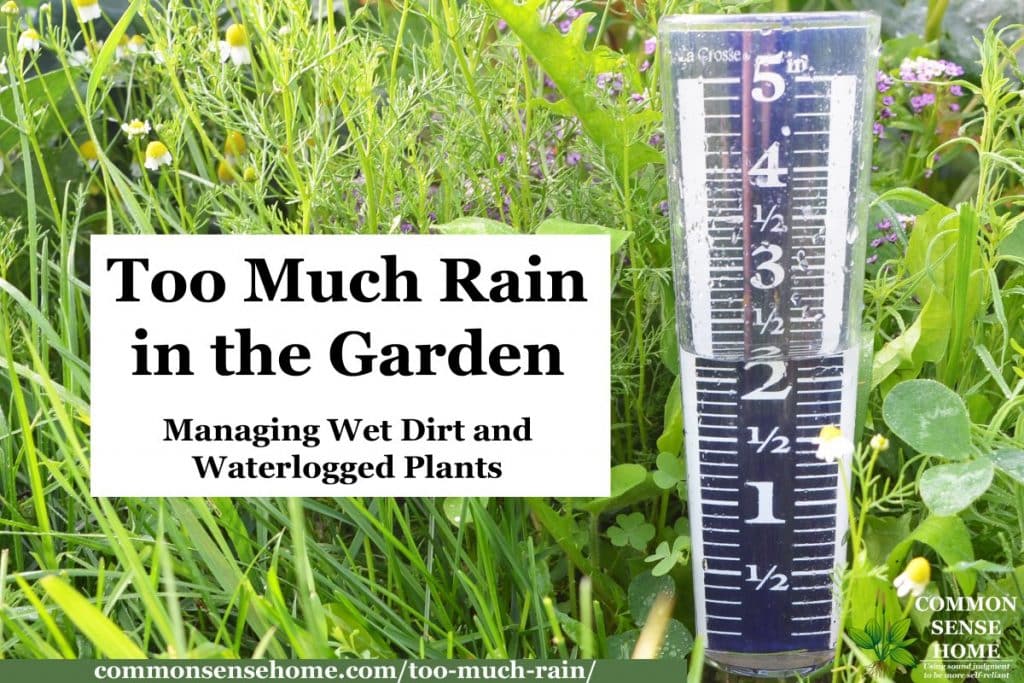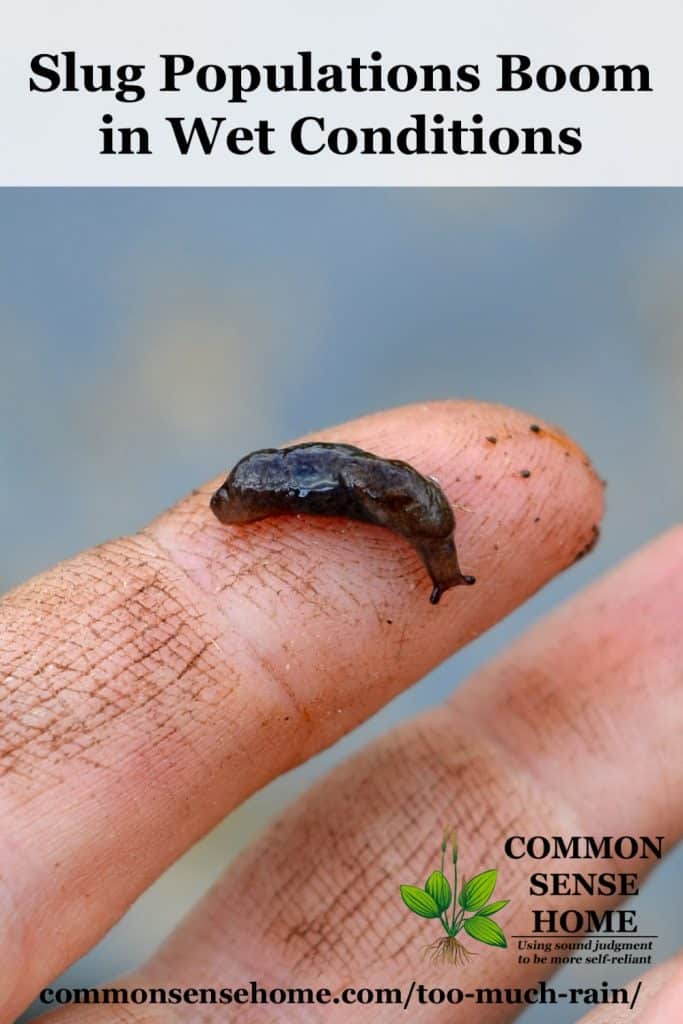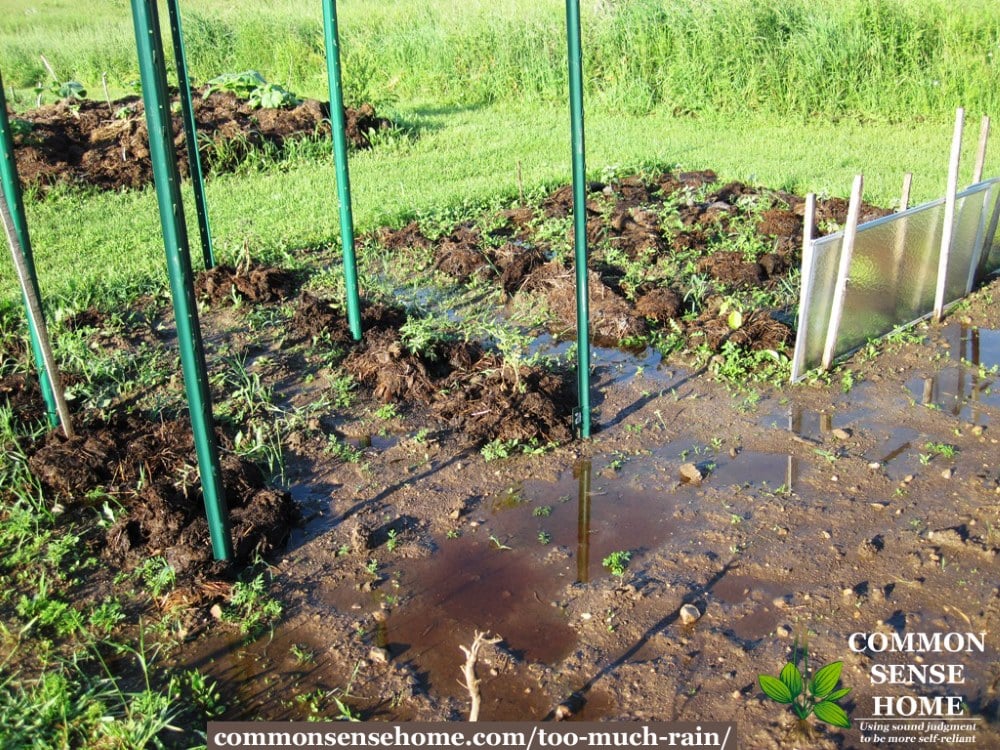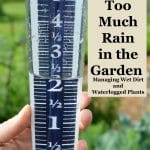Too Much Rain in the Garden – What to Do
Rainwater is best for watering your garden, but too much rain is hard on your soil and your plants. I was watching the morning news the other day, and the weatherman said we had rain 15 days out of the last 16. It rained again that day.
My garden is soggy, but most of it is still in pretty good shape. In this article, we'll talk about wet garden solutions, including steps you can take to prevent damage, and what to do after heavy rains hit. Wet weather might slow plants down, but it doesn't have to end your gardening season.

Too Much Rain in the Garden – How Much is Too Much?
A general rule of thumb for gardening is that plants need roughly one inch of rain per week. Your garden may need more or less depending on soil conditions, ground cover, temperature, and other factors. Some areas, like the Pacific northwest, are known for their heavy rainfall. Other areas, like our part of Wisconsin, are hit with too much rain only rarely. Note: I always recommend talking to local gardeners if possible before starting a garden in a new area. Odds are it will save you a lot of headaches to learn from their experience.
You know you have too much rain when your garden turns into a muddy mess. Plants droop and may even start to rot. (Roots need air in the soil. Too wet/too waterlogged, and they can drown.) You may have standing water in low lying areas. Slug populations are likely to boom. Molds, mildews and other fungal issues can quickly escalate. Don't panic, but do take steps to help out your plants.
Raised Beds or Raised Rows to Dry Our Wet Dirt
If you know too much rain is likely, or you have wet, heavy soil, raised beds are the way to go. Elevating your planting area keeps it dry earlier in spring so you can plant earlier, and allows excess rain to drain away from roots.
The simplest raised bed is soil that is mounded up in a planting area. Walking is restricted to paths between the plant beds, avoiding soil compaction in the beds. This works well with sheet composting. Pile organic matter where you want your garden bed in fall, let it compost over winter, plant in spring.
Low box frames directly on the ground are the next step up, like these ready to assemble cedar garden beds. Some folks also plant in tires, or build frames from concrete blocks or other materials.
The next step up is self-watering planter beds. These planters channel excess water down to a reservoir at the base for later use. An example is the GlowPear Urban Garden Self-Watering Planter.
In our garden, we mound up soil in beds, and also mound up individual rows where needed. Most years, the wind dries out my garden too much, so higher raised beds would be counterproductive. Our wagon wheel garden has permanent paths between beds. In the larger rectangle beds, we make seasonal paths and do raised rows or hilling. An obvious example of this is the potato patch. This year, hilling the potatoes is a “must do”, not a maybe. In between the rows it's squishy, but in the rows the potatoes are dry enough to keep chugging along.

Adding Drainage for Wet Soil
If you have a short term problem, a simple trench funneling excess rain away from your garden may be enough. If soggy soil is an ongoing issue, a French drain or other drain tile may be a good idea. A French drain is a perforated pipe surrounded by gravel. Sod or other groundcover can be added over the top of the drain. The video below demonstrates the installation of French drain in a wet yard.
If you have a hillside in your garden that funnels water into your garden, it may make sense to put up a temporary barrier along the hillside to divert water away from your garden beds.
Mulch or No Mulch in a Wet Garden?
To mulch or not too mulch? My friend, Deb, shared her experience on Facebook:
Go light on the mulch. The mulch can actually slow the soil from drying out. One year when our area was basically flooded, we were able to see this in real life. About three rows of corn were mulched, and the rest was waiting for mulch. The mulched corn began to look washed out and grew very slowly while the unmulched pushed markedly ahead. Eventually it all yielded, but that was an interesting thing to see.
Too much mulch also creates more habitat for slugs to thrive. See “The Ultimate Guide to Natural Pest Control in the Garden” for tips on combating slugs and other pests.
On the flip side, mulch can help keep muddy soil from slashing up on the plants, reducing the chance of some soil borne fungal diseases. Mulch also spreads the force of your footfalls around, so mulched paths reduce soil compaction. I combine light mulch (1-2 inches of straw over old newspapers) with old boards in pathways. (Slugs sometimes hide under boards, so you can use them as slug traps. Flip boards over in the morning and remove the offenders sticking to the underside.)
Note: Later in 2017 we added five runner ducks to the mix, and they've been a tremendous help with the slug population later in 2017 and in 2018. You can read more about the Duck Patrol here.

In some areas, I've skipped the straw mulch entirely. Instead, I'm letting some weeds grow as living mulch to soak up excess rain. Deb shared another snippet on using weeds for excess rain:
When my daughter worked at the landscape business, they would purposefully let weeds grow in some of the pots. These used up excess soil moisture without stressing the trees.
You can read more about using weeds in the post, “5 Reasons I Want Weeds in My Garden“.
Too Much Water on Tomato Plants
Our beloved garden tomato plants also take a hit from too much rain. Different problems your waterlogged tomato plants may have include, but are not limited to:
- Failure to thrive/drooping plants
- Fungal diseases/blight
- Blossoms but no fruit
- Cracked fruit
- Blossom end rot
Failure to Thrive/ Drooping Plants
First, let's look at drooping, waterlogged plants. Tomatoes will put out new roots from the stem, so one option is to heap additional soil or compost around the base of the plant. This gives the plant a new root area above the wet soil. I used this to save my tomato patch during another extremely wet year. Even without added dirt, if you can improve drainage, with better weather the plants will likely recover.

Fungal Diseases/Blight
Fungal diseases love nothing better than damp conditions, and once started, they're hard to stop. As mentioned above, light mulch will help slow down soil borne fungus. You can also remove leaves close to ground level to reduce the spread of spores. Some spores are carried on the wind, so you can't avoid them entirely.
Growing tomatoes on a trellis improves air flow, reducing disease pressure. (This helps for other vine crops, too. See 5+ Terrific Tomato Trellises for trellis ideas.) Prune plants as needed to ensure good air flow and sun exposure. Dry conditions and sunlight both reduce fungal stress.
Remove diseased foliage and discard in the trash, or bag and take it to your local extension office for identification. (Clean clippers after use so you don't spread the spores.) Cornell University has a good diagnostic page for tomato diseases.
To fight bad microbes with good microbes, consider using mycorrhizal fungi, compost tea or Effective Microorganisms in the garden to strengthen your plants' defenses.
Blossoms But No Fruit
Pollinators have a hard time getting around in the rain, and wet pollen doesn't carry well on the wind. For a variety of suggestions to help your tomatoes set fruit, see “Tomato Flowers but No Fruit – 9 Troubleshooting Tips.”
Cracked Fruit
Too much rain or moisture at one time can cause tomatoes to burst at the seams. This can also happen with other garden produce, such as radishes or melons. Once a fruit cracks, it's best to use it as soon as possible. In the future, you can look for crack resistant varieties, or take steps to reduce soil wetness before the fruits are ripe.
Blossom End Rot
Blossom end rot is a black, rotten area at the blossom end of the tomato. It's most common in extreme dry conditions, but also happens with extreme wet. The problem is caused because tomato plants can't take up enough calcium from the soil. Common solutions include tomato fertilizers with added calcium, crush eggshells, garden line, and antacids. To learn more, visit “7 Steps to End Blossom End Rot and Get Rid of Black Bottomed Tomatoes“. Like cracked fruit, blossom end rot may also show up with other garden plants, such as summer squash or melons.
More Gardening Tips
Do you have other tips for dealing with heavy rains, or questions I haven't addressed? Leave a comment below. As always, sharing is much appreciated. If you enjoy the post, let others know, too.
You may also find useful:
- Rainwater Harvesting
- Small Garden, Big Yield – 10 Tips for a Great Harvest
- 20 Things I Wish I Had Before the Flash Flood Emergency



I have a raised bed above a waterlogged soil. The beds are so wet inside that some plants are dying off due to lack of oxygen. Does drilling holes in the side of the bed help drainage? Any good tips? It’s filled with manure compost at the moment.
Drilling holes in the side of the bed certainly should allow more water to exit at a faster pace. It might drain too much once normal levels of rainfall return, but it should help deal with the immediate issue. Top dressing with some more dry organic material may give roots a little more room above the high water level.
I live in Olympia WA. Last fall I purchased 3 galvanized raised beds (6’8” x 3’4” x 1’5” tall) for my south facing garden. As instructed I placed weed barrier or cardboard before adding organic garden soil (purchased by our condo yard maintenance crew). Two issues.
1. The beds are mud from the PNW rain.
2. When I tested the sail yesterday, it was totally depleted of all nitrogen, phosphorus, potash and ph acidity/alkalinity (per 9 month old Rapitest Kit)..
Could the rain have washed everything away or did I receive j
Inferior soil?
Is there anything I can add or do so the soil drains better? Or possible add a vegtrug frame ?or similar?
I’m originally from
California so having to deal with rain and wet soil is new to me!
Thank you
What is the best organic matter to add to improve the sail?
I haven’t dealt firsthand with the heavy rains of the Pacific northwest, but I can offer some possibilities.
The Rapitest kits can be unreliable, even when new, so it might not be as bad as it looks. Is anything growing in the beds (weeds, volunteer plants)? Looking the plant health is one of the simplest forms of soil analysis. Your weeds tell a lot about your soil.
In the article “Soil Testing – 5 Easy Tests for Your Yard and Garden“, I talk about things to look for in plant growth to help you identify deficiencies in the soil. I also talk a little about soil structure, which I suspect will be something you need to work with more than most due to the heavy rains.
If you got just soil, no matter how good the soil was initially, heavy, extended rains will take a toll, especially in a raised bed situation. I’ve read more about the Amazon rainforest than the temperate rainforest, but I suspect some of the same issues apply. The slash and burn farming that cuts down/burns the forest and then plants has to keep doing more of the same, because the heavy rains wash the nutrients out of the soil. The nutrients are held in the vegetation.
While you certainly wouldn’t want to be slashing and burning to create new garden space, I suspect that you’re going to need more organic matter – compost, mulch, branches, spoiled bedding, leaves – to keep amending your soil on a regular basis. Another thing you may want to look into in biochar. This inoculated charcoal was used to make Terra Preta (dark, fertile soil) that held its fertility in the Amazon. You can read more about that in the article “Biochar – Amazon Secret Rediscovered“.
As for organic matter, almost anything will help, as long as it’s not poison, which has unfortunately become a serious problem. Persistent herbicides are turning up in more yard and field wastes. I talk more about organic matter in Composting 101.
The organic matter is likely to decompose quickly, so regular amendments will probably be needed. With enough organic matter, the soil becomes lighter, fluffier, and more sponge like, retaining workability even when wet. If you have bad mud right now, you’ll probably need to wait until it dries more to work it. Trying to work with extremely muddy soil tends to exacerbate the problem.
Are there any local gardening clubs, or have you met any local gardeners that you could talk to about dealing with the rains? That’s something I recommend if possible when gardening in a new area. Find someone who does it well and learn from them.
Another thing to watch out for is slugs. With the yummy garden plants and organic matter breaking down, they see a buffet. In the book “The Resilient Gardener“, the author got ducks to deal with the slugs. Ducks LOVE slugs, and can turn them into tasty eggs, or meat, if you’re so inclined. Our chickens don’t like slugs nearly as much as the ducks do. The ducks treat them like candy.
I can’t recall if she included much else about dealing with the heavy rains, as it’s been several years since I read the book and I may have skimmed that section since we don’t normally have heavy rains here in Wisconsin. The book was part of our inspiration for getting ducks, though we ended up with a small flock of runners that we use for eggs but not meat. They’ve become more like pets, and come when we call. There’s more on the ducks in the garden in “Duck Pest Control“.
I live in a Town Home community…and it was poorly graded from the get go. Unfortunately my end unit is where all the rain drains to/by. Luckily Ive built up the bed around my deck enough that it becomes small stream when it rains heavy. It, for the most part, runs down and around my weeping cherry and grasses that hides my heat pump but then it hits my pipe that exits the sump pump water and then the gutter downspout. It’s all suppose to drain to a large grassy hole between two other buildings further down the “hill”/”grading” but it mostly just sits at the side of my house and in, well the stream around my bed. Ive read all the french drain articles butI have no where to really drain it too if I install the pipe under ground. Does it help any to do something similar with just stone in order to move the water through and not let it sit and or wash away the soil? Just curious what pool have tried because Ive google everything and short of hiring a professional I thought I’d ask.
If there’s no where for the drain to drain to, the water will be trapped in it – maybe even more than it is already, because you’re lowering the grade slightly. It may reduce erosion and provide a better channel for the stream, but if the water hangs around too long, it could also create a stinky biomat scum layer in the drain channel. I’m guessing here because I can’t measure the grade or precisely visualize the situation (and my degree is in mechanical engineering, not civil engineering).
I suggest planting something in the area that is water loving. It should help dry that spot up. Like bamboo, willow, violets. Something like a wet garden.
we tilled in compost and aged manure , then I raked that into raised rows. I loosened the soil in the walkways with a 2 wheel planet Jr cultivator with the 8″ scuffle hoe on it . Then took the soil from between the rows and mounded it on the planing rows . and in the low area I put composted manure then composted screened ramial wood chips ! this should give me better drainage this summer as well as help to elevate the garden area a little above the rest of the yard adding organic matter each year seems to really help
In 2011 I did not have a garden due to the fact that my husband usually tilled my garden after his corn was planted (It was a big Troybilt that I could not handle). That year we had flooding in our area and I started a full time job, so the corn did not get planted until mid June–thus no garden. That fall, I purchased from my boss a rat chewed roll of 12 foot wide by 100 meter long plastic ground cover and completely covered my garden. The following spring I installed 12 6 foot long by 18 inches wide by 18 inches high Smart Pots for my raspberries, black raspberries and blueberries. I also had some 20 gal Smart Pots for my veggies. They have worked extremely well–less weed maintenance and you cannot over water. My only problem now is when it is dry, I have to water more often. So last year was a challenge because it was so dry and two of our 3 wells had problems and I could not use them, and I did not want to over use the house well (need indoor plumbing!). I now have an old bulk tank that collects rain water from a small 10 ft x 10 ft building (old milk house) and I have two rain barrels on the house. Last year I used the collected rain water judiciously (blueberries and the corn), but this year everything is now full to the brim and I don’t need the collected rain water–at least not yet!
Bottom line, the Smart Pots are very handy, I love the idea of the air pruning of the roots, but they are starting to look ragged for being outside for 7 years, so am looking at maybe doing raised wooden beds with dimpled plastic foundation or floor liner and then a layer of plastic ground cover for air pruning of the roots. Summer project weather permitting! Good luck fellow gardeners!
I have been having issues with my garden holding water. So, after it finally dried out, I re-tilled the area and added some compost to the soil, then I created taller rows to keep the seeds out of the standing water. I re-planted tomatoes, okra, and cucumbers once I made my rows taller, but now I have a green film (I am assuming algae) growing on the soil and it smells like a pond. Are my seeds going to take off okay? or should I add more soil to the area?
It’s tough to say without seeing what’s going on and touching and sniffing the soil. If the seeds don’t rot, they should be able to grow and deal with the algae, but if the soil is too wet, they’ll just rot.
We are getting so much rain and I’ve planted tomatoes and it’s too much rain so I cut plastic with slits and placed around plants and secured with rocks. Is this going to be ok until better weather. No sun here either
There’s some good and bad about using plastic to try and protect the plants. It’ll keep the mud down, and may route water away from the plants. The down side is that the soil under the plastic may take longer to dry, as the plastic traps the moisture, and provide shelter to slugs.
Watch your plants and see how they are reacting. If they seem to be doing worse with the plastic in place, take it off. If it seems to help, leave it on.
We gardened with straw bales one year in a spot that slopes towards the garden. The bales needed to be waterd daily. Did you ever try them in wet weather? It seems to me they are like a deep bed made of straw. I have found that beds like that need less water, but do not have as much of a slug problem as heavily mulched beds.
I have not tried straw bale gardening because we get so much wind here that I know it would suck the moisture right out of the bales. Also, it’s very difficult to find small rectangular bales. almost all the local farmers that are left have switched to the big round bales.
I suspect that heavy rain would be prone to leach out nutrients faster, so you’d probably need to top dress the bales with some sort of fertilizer. Heavy rain is also likely to speed up decomposition, so your bales might become unstable if the rains are bad enough. Other than that, they certainly could keep your plants up out of the sodden ground.
Good point about the wind. We have lost a few garden structures to our gusty blasts. Thinking back to our first year garden, we stationed most of our bales along the south side of the steel building we installed before we built our cottage. This building is on a gravel pad, so planting into it won’t work and I suspect may de-stabilize it over time. It was amazing how much it protected the bale garden from our gusty winds and increased the amount of warmth and reflected light around the bales. I think we added a few days to our short 76 day season, and we got by with covering the squash crop with plastic several times over the weeks into October when frost started to hit.
Joel Karsten cautions against adding fertilizer beyond what is used to condition the bales to prevent fungal overgrowth. We wanted to go organic, and used rabbit’s blood as the conditioner. But just in case I dug a little past the mid-point into the bale and shoved a couple of hand fulls of composted pastured cow manure into it, With a thick topping of seedling mix on top as a buffer. I also spaded a good shovelful of the same into the soil underneath where I positioned the bales. No fungal problems and we had scary huge vines. I think one of the buttercups had at least 14 good sized squashes. We kept finding more as the foliage froze deeper into the vines.. The way it is raining these days, and rained last summer, I think it might be worth trying again.
The greatest hazard we will have will probably be that we let our hens out for a couple hours a day to graze scratch for bugs, and they will want to hop up on top and scratch in the straw unless I can figure out an effective, cheap barrier. The bales themselves held together quite well that first year and made excellent mulch for potatoes the second year.